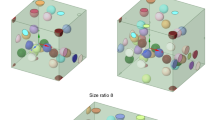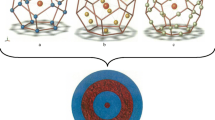Abstract
In this paper, the finite element simulation approach for studying the steady-state heat transfer and predicting the effective thermal conductivity of composites has been proposed. 3D representative volume elements considering the polyhedral- and spherical-shaped inclusions are generated. Different meshing approaches for meshing these complex structured composites have been used, and the mesh quality is studied based on mesh metrics: element quality and skewness, and next, a convergence study is conducted to ensure mesh-independent results. Three different boundary conditions: mixed, constant temperature gradient and uniform flux has been used to predict the effective thermal conductivity of composites. The predicted results from simulations are in good agreement with the experimental values reported in the literature. It has been observed that the random orientation and interpenetration of particles lead to a much better heat flow and hence the higher values of effective thermal conductivity of composites. For high volume fraction composites, as the number of particles having interpenetration increases, their effective thermal conductivity increases. For low volume fraction composites, constant temperature gradient boundary condition overpredicts the effective thermal conductivity and for high volume fraction composites, uniform heat flux and mixed boundary conditions predict higher values. A design point study was conducted, considering the ratio of thermal conductivity of constituents, as a design parameter. It has been observed that by reinforcing the high thermal conductivity inclusions as an interpenetrating phase, the effective thermal conductivity of composites can be increased substantially. The reinforcement of very high conductivity material cannot yield the desired ETCs if the reinforced particles are rendered uniformly oriented with no contacts between them.









Similar content being viewed by others
References
Hasselman DPH, Johnson LF. Effective thermal conductivity of composites with interfacial thermal barrier resistance. J Compos Mater. 1987;21:508–15.
Faroughi SA, Huber C. Effective thermal conductivity of metal and non-metal particulate composites with interfacial thermal resistance at high volume fraction of nano to macro-sized spheres. J Appl Phys. 2015;117:55–104.
Yu H, Heider D, Advani S. Prediction of effective through-thickness thermal conductivity of woven fabric reinforced composites with embedded particles. Compos Struct. 2015;127:132–40.
Lee S, Lee J, Ryu B, Ryu S. A micromechanics-based analytical solution for the effective thermal conductivity of composites with orthotropic matrices and interfacial thermal resistance. Sci Rep. 2018;8:72–66.
Quang HL. Determination of the effective conductivity of composites with spherical and spheroidal anisotropic particles and imperfect interfaces. Int J Heat Mass Transf. 2016;95:162–83.
Kim SY, Noh YJ, Yu J. Thermal conductivity of graphene nanoplatelets filled composites fabricated by solvent-free processing for the excellent filler dispersion and a theoretical approach for the composites containing the geometrized fillers. Compos Part A: Appl Sci Manuf. 2015;69:219–25.
Bonfoh N, Dreistadt C, Sabar H. Micromechanical modeling of the anisotropic thermal conductivity of ellipsoidal inclusion-reinforced composite materials with weakly conducting interfaces. Int J Heat Mass Transf. 2017;108:1727–39.
Lijia Q, Xuming P, Jianqiu Z, Jingxin Y, Shishun L, David H. Theoretical model and finite element simulation on the effective thermal conductivity of particulate composite materials. Comp Part B. 2017;116:291–7.
Sharma NK, Misra RK, Sharma S. Experimental characterization and numerical modeling of thermomechanical properties of Al-B4C composites. Ceram Int. 2017;43:513–22.
Sharma NK, Misra RK, Sharma S. Thermal expansion behavior of Ni/Al2O3 composites with particulate and interpenetrating phase structures: an analysis using finite element method. Comput Mater Sci. 2014;90:130–6.
Langer SA, Fuller ER Jr, Carter WC. OOF: image-based finite-element analysis of material microstructures. Comput Sci Eng. 2001;3(3):15–23.
Sharma NK, Misra RK, Sharma S. Modeling of thermal expansion behavior of densely packed Al/SiC composites. Int J Sol Struc. 2016;102–103:77–88.
B€ohm HJ, Eckschlager A, Han W. Multi-inclusion unit cell models for metal matrix composites with randomly oriented discontinuous reinforcements. Comput Mater Sci. 2002;25(1):42–53.
Jaesang Y, Lacy TE, Toghiani H, Pittman CU. Micromechanically- based effective thermal conductivity estimates for polymer nanocomposites. Compos Part B Eng. 2013;53:267–73.
Tian W, Qi L, Chao X, Liang J, Fu MW. Numerical evaluation on the effective thermal conductivity of the composites with discontinuous inclusions: Periodic boundary condition and its numerical algorithm. Int J Heat Mass Transfer. 2019;134:735–51.
Hua Y, Gu LX. Prediction of the thermomechanical behaviour of particle reinforced metal matrix composites. Compos Part B Eng. 2013;45(1):1464–70.
Tong Z, Liu M, Bao H. A numerical investigation on the heat conduction in high filler loading particulate composites. Int J Heat Mass Transfer. 2016;100:355–61.
Shao C, Bao H. A molecular dynamics investigation of heat transfer across a disordered thin film. Int J Heat Mass Transfer. 2015;85:33–40.
Tian Z, Han H, Ying S. A molecular dynamics study of effective thermal conductivity in nanocomposites. Int J Heat Mass Tran. 2013;61:577–83.
Behrang A, Taheri S, Kantzas A. A hybrid approach on predicting the effective thermal conductivity of porous and nanoporous media. Int J Heat Mass Tran. 2016;98:52–9.
Xing J, Radovic M, Muliana A. Thermal properties of BaTiO3/Ag composites at different temperatures. Comp Part B. 2016;90:287–301.
Gao BZ, Xu JZ, Peng JJ, Kang FY, Du HD, Li J, Chiang SW, Xu CJ, Hu N, Ning XS. Experimental and theoretical studies of effective thermal conductivity of composites made of silicone rubber and Al2O3 particles. Therm Acta. 2015;614:1–8.
Maxwell JC. A Treatise on Electricity and Magnetism. UK: Clarendon Press; 1881.
Deissler RG, Boegli JS. An investigation of effective thermal conductivities of powders in various gases. ASME Trans. 1958;80:1417–25.
Xu JZ, Gao BZ, Kang FY. A reconstruction of Maxwell model for effective thermal conductivity of composite materials. App Therm Engg. 2016;172:972–9.
Chu Ke, Jia C, Tian W, Liang X, Chen H, Guo H. Thermal conductivity of spark plasma sintering consolidated SiCp/Al composites containing pores: Numerical study and experimental validation. Comp Part A. 2010;41:161–7.
He QC. Effects of size and boundary conditions on the yield strength of heterogeneous materials. J Mech Phys Solids. 2001;49(11):2557–75.
Huet C. Coupled size and boundary-condition effects in viscoelastic heterogeneous and composite bodies. Mech Mater. 1999;31(12):787–829.
Kanit T, Forest S, Galliet I, Mounoury V, Jeulin D. Determination of the size of the representative volume element for random composites: statistical and numerical approach. Int J Solids Struct. 2003;40(13–14):3647–79.
Terada K, Hori M, Kyoya T, Kikuchi N. Simulation of the multi-scale convergence in computational homogenization approaches. Int J Solids Struct. 2000;37(16):2285–311.
Xia Z, Zhang Y, Ellyin F. A unified periodical boundary conditions for representative volume elements of composites and applications. Int J Solids Struct. 2003;40(8):1907–21.
Çengel YA, Gjhajar AJ. Heat and mass transfer: fundamentals & applications. 5th ed. New York: McGraw-Hill; 2011.
Author information
Authors and Affiliations
Corresponding author
Additional information
Publisher's Note
Springer Nature remains neutral with regard to jurisdictional claims in published maps and institutional affiliations.
Rights and permissions
About this article
Cite this article
Sharma, N.K. Finite element modelling and simulations on effective thermal conductivity of particulate composites. J Therm Anal Calorim 147, 3441–3452 (2022). https://doi.org/10.1007/s10973-021-10756-9
Received:
Accepted:
Published:
Issue Date:
DOI: https://doi.org/10.1007/s10973-021-10756-9




